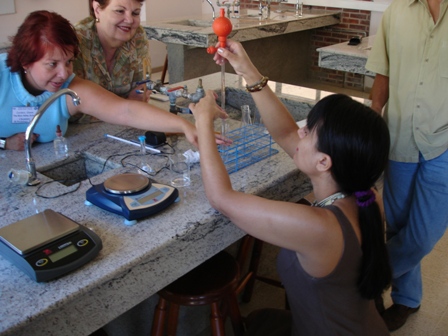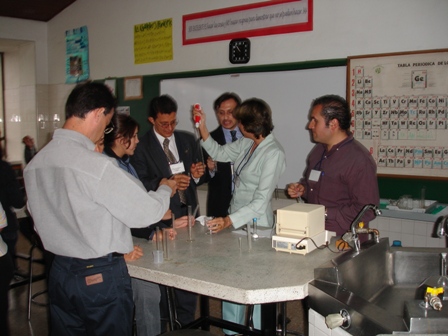A green acid-base practical
Background
In 2008 a Living Planet report calculated that humans are using 30% more resources than the Earth can replenish each year. As more and more people from the developing world aspire to the same quality of life as those from the developed world the rate of depletion of resources will increase even more. In IB chemistry we are encouraged to consider environmental issues and green chemistry in our teaching. 'Aim 8' involves raising awareness of the ethical issues of being a global citizen. I have developed an environmentally friendly practical that mimics the situation we find in the world where resources are finite. This usually takes about 1.5h and is great for seeing how your students can work as a team to solve a problem. Because it only involves extremely small quantities of chemicals I have used it successfully in workshops with teachers as well as with my own students. I usually do the experiment after they have done the acid-base titration where they realise from the audit of that experiment that the most costly chemical they used was distilled water. Although it is unusual it would actually cover the mandatory laboratory components for both Topic 1.3 Reacting masses and volumes 'Use of the experimental method of titration to calculate the concentration of a solution by reference to a standard solution' and Topic 8.2 Properties of acids & bases 'Candidates should have experience of acid-base titrations with different indicators'.


Teachers doing the experiment at workshops in San Jose, Costa Rica [left] and Bogota, Colombia [right]
Teacher's notes
This is an interesting experiment and leads to a great discussion afterwards. By doing the experiment students gain a real understanding of quantitative chemistry. They also really enjoy the challenge and you can have fun telling them that no more chemicals (including water) can be used, even to wash up. Both students and teachers almost invariably approach this problem by using volumetric apparatus. If the school has micro-syringes then these may be chosen but more often than not students opt for 5 cm3 measuring cylinders. These will give an answer but of course the uncertainty is huge. If you look carefully at the two photographs you will see that the most accurate measuring instrument in the laboratory is not being used. The best way to solve the problem is for all the groups to decide to make up one common solution of the acid using a few drops of indicator solution and about 20 cm3 of the water but it is the mass of the solute and all the solvents that should be measured not the volume. Each pair then takes a known mass of about 1 cm3 of the solution and titrates it drop-wise on the balance with the sodium hydroxide solution. This is then repeated. The balance can mass to plus or minus 0.001 g so that the uncertainty when weighing 1 g is still very small (+ or – 0.1%). The only real assumption that has to be made is that the density of the water and the solutions is 1 g cm-3. By doing this a very accurate answer can be obtained – and there is still 5 cm3 of the water remaining to do the washing up! The answer should be 97.0.
Can you get the students to think of a monoprotic acid with a relative molecular mass of 97?
They usually initially think it must be an organic acid but then realise that no organic acid fits as most with a low molecular mass are liquids and benzoic acid (Mr = 122) which is a solid has a mass far too high. The acid is in fact sulfuric acid in which one of the –OH groups has been replaced by an –NH2 group to give HSO3NH2 which is known as sulfamic acid.
I once had a student give a brilliant hypothesis for this experiment. He reasoned that as such small quantities are given it is unlikely that any one of the reactants is in a huge excess. If exactly equimolar amounts of the acid and alkali are provided then the relative molecular mass works out to be 96.0. Therefore he hypothesised that the answer would be close to 96.0. I wish I was that clever!

 Student worksheet
Student worksheet
TO PLAN AND CARRY OUT A COST EFFECTIVE AND ENVIRONMENTALLY FRIENDLY EXPERIMENT TO DETERMINE THE RELATIVE MOLAR MASS OF A MONOPROTIC ACID.
INTRODUCTION:
In real life resources are scarce. Once they are used up they are no longer available. In this experiment you are confronted with exactly this situation.
The aim of this experiment is for you to plan your own method to find the relative molar mass of an unknown monoprotic acid. You should devise a method to achieve as accurate result as possible.
ENVIRONMENTAL CARE:
The whole point of this practical is to minimise the effect on the environment as such small quantities are used.
SAFETY:
Provided you follow normal safe practice there are no additional hazards associated with this experiment.
PROCEDURE:
You are provided with a finite amount of substances. Working in pairs you may use any apparatus in the laboratory that you wish. As this is a scientific experiment each pair should aim to repeat the experiment to get a reproducible result.
Remember that once you have used up all your resources (including the water) no more will be provided.
Resources available for the whole class :
25.0 cm3 of 0.100 mol dm-3 NaOH(aq)
0.240 g of an unknown monoprotic acid
25.0 cm3 of distilled water
phenolphthalein indicator solution
DISCUSSION:
1. Evaluate the method you chose. What were the main sources of error?
2. Having had more time to reflect could you now devise a better method?
This worksheet can also be downloaded from:

 IB Docs (2) Team
IB Docs (2) Team